![]()
![]()
![]()
Use LEFT and RIGHT arrow keys to navigate between flashcards;
Use UP and DOWN arrow keys to flip the card;
H to show hint;
A reads text to speech;
40 Cards in this Set
- Front
- Back
|
Clastic Transport and Fluid Flow
|
1. MASS WASTING
2. FLUID FLOW 3. ENTRAINMENT, TRANSPORT, DEPOSITION OF CLASTS IN FLUID FLOW 4. SEDIMENT GRAVITY FLOWS |
|
|
Types of Transportation
|
1. MASS WASTING
A. Gravity dominates B. Fluids insignificant 2. FLUID FLOW A. Clasts not abundant 3. SEDIMENT GRAVITY FLOW A. Fluid (water or air) significant B. Gravity significant C. Clasts very abundant |
|
|
MASS WASTING
|
1. Dry and Freefall
A. Rock falls - Through air B. Avalanches - Along ground - Grain flow |
|
|
Rockfall from vertical cliff
|
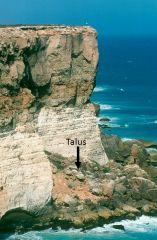
|
|
|
Talus cone: Montana
|
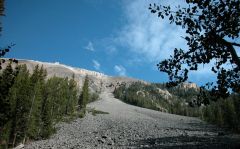
|
|
|
FLUID FLOW OR HYDRAULICS
|
1. Fluids
A. Gases B. liquids 2. Change shape 3. Resist change in volume |
|
|
Ability of Fluid to Erode and Transport Sediment
|
1. Density
A. MASS/VOLUME - Sea Water 1.03 g/cm3 - Water 1g/cm3 - Ice 0.9 g/cm3 2. Viscosity A. Resistance to flow or shearing 3. Velocity A. Distance/Time |
|
|
Style of Fluid Flow
|
1. Laminar
2. Turbulent |
|
|
Laminar Flow
|
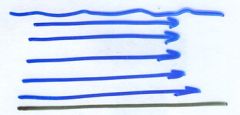
1. Parallel or subparallel to underlying boundary surface
2. Parallel or subparallel to other molecules in the fluid 3. Can only move down current or down wind 4. Generally ineffective at erosion and transportation 5. Transportation may be effective IF viscosity prevents deposition 6. Present in very slow moving fluids A. Slow tidal currents B. Sheet flows 7. Present in very viscous fluids A. Ice B. Mud-supported gravity flows 8. Unusual in most stream and eolian environments |
|
|
Turbulent Flow
|
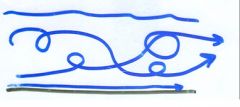
1. Flow is random
2. Flow direction may be up, down, down current, or up current 3. Common in most natural environments 4. Effective in erosion A. Flow direction upward 5. Effective in transportation A. flow direction upward |
|
|
Channelized flow
|

Turbulent flow dominates
|
|
|
Froude Number: Description
|
1. Ratio Fr = V÷√gD
2. Inertial forces A. velocity (V) 3. Gravitational forces A. Gravitational force (g) B. Depth (D) |
|
|
Froude Number: Meaning
|
1. Fr more than or equal to 1 = rapid flow
2. Fr equal to 1 = threshold 3. Fr less than or equal to 1 = tranquil flow This controls the bedform – ripples, dunes, laminar bedding, etc. |
|
|
Hydraulic Jump
|
1. Sudden decrease in Froude #
2. Turbulence 3. Common cause is increase in depth |
|
|
Entrainment
|
1. Lift Force (vertical)
2. Drag Force (horizontal) 3. Gravitational Force (no lift or drag) |
|
|
Entrainment Lift Force = Bernoulli’s Principle
|

|
|
|
Entrainment
|
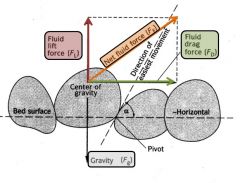
|
|
|
Erosion, Transportation, and Deposition
|

|
|
|
“?” Floculate
|
1. Clay and Silt particles clump together
A. cohesive B. Edge charges C. As clumps act of larger grains D. Require velocity adequate to erode “clump” |
|
|
Transportation in a Stream
|

|
|
|
Settling Velocity: Stokes Law
|
1. Depends on
A. Viscosity of fluid (Indirectly proportional) - Warm water less viscous - Cool water more viscous B. Density of grain (directly proportional) 2. Assumes Perfect spheres A. No velocity |
|
|
Hydraulic Equivalency
|

1. Clasts that settle at SAME velocity
A. Size B. Shape C. Angularity D. Density |
|
|
Sediment Gravity Flows
|
1. Movement principally by gravity, NOT fluid motion
A. Properties of solid flows B. Properties of fluid flows - Some fluid (water or air) is required |
|
|
Four Types Sediment Gravity Flows
|
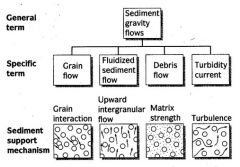
1. Grain Flow
2. Fluidized Flow 3. Debris Flow 4. Turbidity Current |
|
|
Grain Flow
|
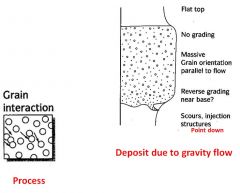
1. Cohesionless sediment
2. Air or water A. No directed pressure B. Just a buffer between grains |
|
|
Debris Avalanche – Fast, Dry
|

|
|
|
City in the path of an avalanche
|

|
|
|
Fluidized Sediment Flow: Liquefaction (Quick sand)
|
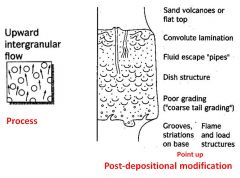
1. With no pore pressure – solid saturated sand and gravel confined in at least 3 directions
2. Pore water under pressure A. Weight of overlying sediment B. Shock waves - Earthquakes - Explosions 3. Pore water moves upward = directed pressure 4. Grains supported by pore water 5. Pressure is reduced – becomes solid again |
|
|
Liquefied Sand – New Madrid Earthquakes
|
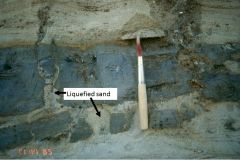
|
|
|
Ground failure due to liquefaction of sand during earthquake
|
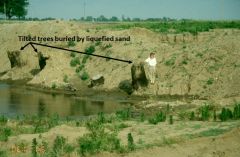
|
|
|
Debris Flow
|
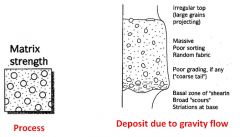
1. Dense fluid of sediment (clay-gravel) + water
2. Can transport LARGE grains 3. Viscous |
|
|
Diamicton
|
1. Any very poorly sorted deposit without regard to origin
A. Debris flow B. Till |
|
|
Flow
|
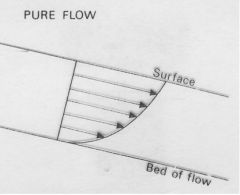
Fluids are important and internal deformation is significant
|
|
|
Debris Flow
|
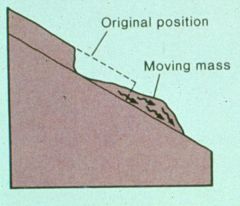
|
|
|
Debris Flow and Lahars – Fast, Wet
|
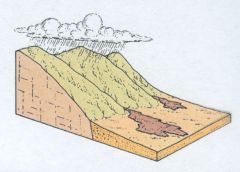
|
|
|
Mudflow
|

|
|
|
Debris flows
|
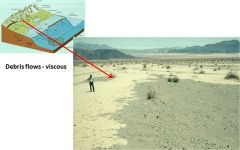
1. Poorly sorted
2. Poorly rounded 3. Poor bedding |
|
|
Volcanic Mudflow
|
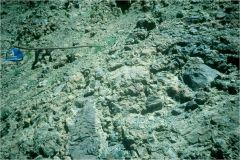
|
|
|
Turbidity Current - subaqueous
|

1. With no pore pressure – solid saturated sediment on slope
2. Pore water under pressure A. Earthquake Shock waves 3. Pore water moves turbulently 4. Grains (sand and gravel) supported by pore water 5. More dense than surrounding water 6. Flows downslope 7. Alternates with normal marine/lacustrine shales |
|
|
Environments of Deposition
|
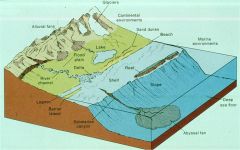
|

